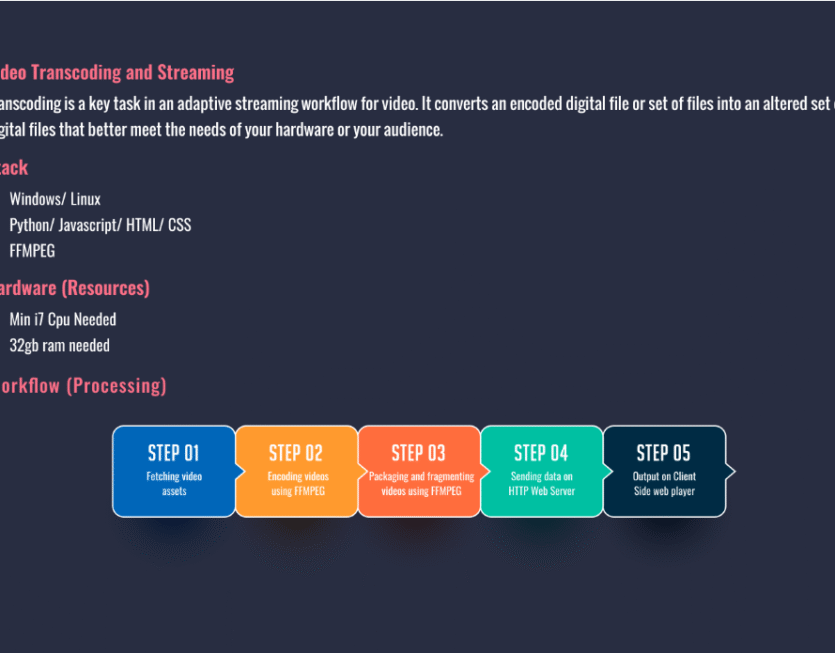Video Transcoding and Streaming
Our cutting-edge video transcoding system is designed to convert encoded digital files into multiple formats optimized for adaptive bitrate streaming. This project leverages state-of-the-art encoding techniques and efficient workflows to deliver high-quality video content across various devices and network conditions.
Technology Stack
- Operating Systems: Windows, Linux
- Programming Languages: Python, JavaScript
- Frontend Technologies: HTML5, CSS3
- Core Transcoding Engine: FFmpeg
- Web Framework: Flask/Django
- Streaming Protocols: HLS, DASH, MP4
Hardware Requirements
- Processor: Intel i7 or equivalent (minimum)
- RAM: 32GB (minimum)
- Storage: High-speed SSD for optimal performance
- GPU: NVIDIA GPU for hardware-accelerated encoding (optional but recommended)
Workflow
- Asset Ingestion:
- Secure fetching of video assets from various sources
- Validation of input formats and metadata
- Transcoding:
- Utilize FFmpeg for high-quality, efficient encoding
- Generate multiple renditions (resolutions, bitrates, frame rates)
- Packaging and Fragmentation:
- Create HLS and DASH manifests
- Segment videos for adaptive streaming
- Distribution:
- Deploy encoded assets to HTTP web server
- Implement CDN integration for global content delivery
- Playback:
- Develop a responsive HTML5 player with adaptive bitrate capabilities
- Ensure cross-browser and cross-device compatibility
Key Features
- Multi-Resolution Support: 720p, 480p, 144p
- Frame Rate Options: 30 FPS, 15 FPS
- Adaptive Bitrate Streaming: Dynamic quality adjustment based on network conditions
- Multiple Output Formats: HLS, DASH, MP4
- Real-time Encoding: Support for live streaming transcoding
- Analytics Dashboard: Monitor transcoding performance and viewer statistics
Unique Selling Points
- Optimized Encoding Profiles: Tailored encoding settings for various content types (e.g., sports, movies, news)
- Smart Bitrate Ladder: Automatically generate optimal bitrate ladders based on content complexity
- Low-Latency Streaming: Implement cutting-edge techniques to minimize end-to-end latency
- Content-Aware Encoding: Adjust encoding parameters dynamically based on scene complexity
- DRM Integration: Support for major digital rights management systems
Deployment
- Containerized application using Docker for easy scalability and deployment
- Load-balanced server setup to handle high concurrent transcoding requests
- Integration with cloud services (AWS, Azure, GCP) for on-demand scaling
Applications
- OTT Platforms: Deliver high-quality streaming experiences for on-demand and live content
- Broadcast Media: Enable efficient distribution of news and live events across multiple platforms
- E-Learning: Provide adaptive streaming for educational video content, ensuring accessibility across various devices and network conditions
- Corporate Communications: Facilitate high-quality video conferencing and internal content distribution
- Social Media: Enable efficient video sharing and streaming o



